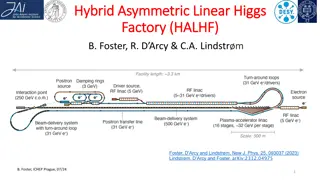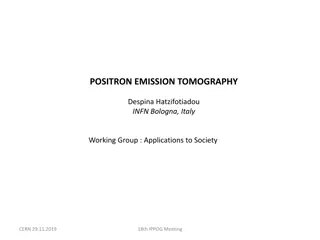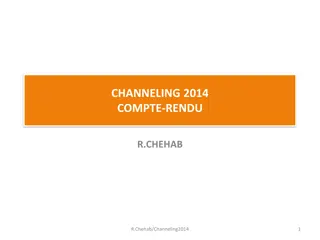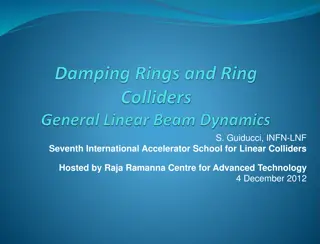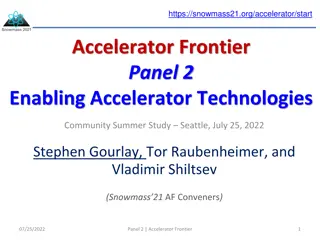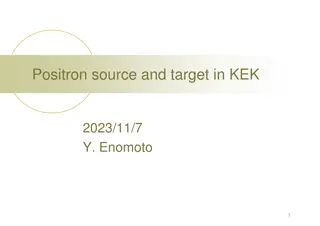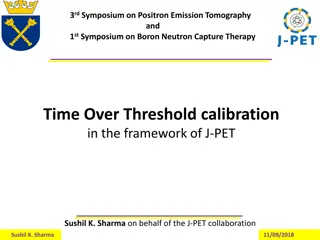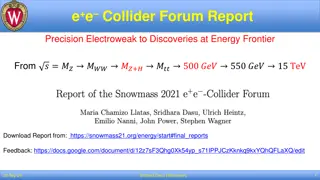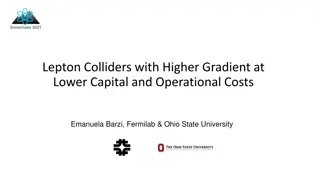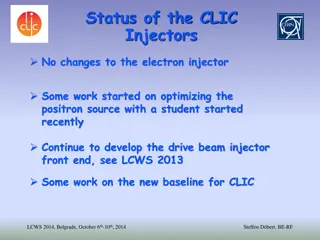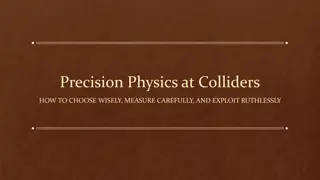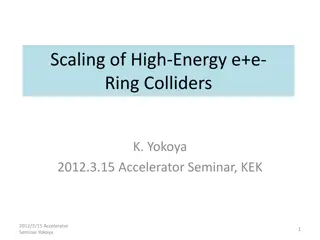Review of Positron Source R&D for Linear Colliders by R. Chehab
Intense positron sources, whether polarized or not, are vital for future e+e- linear colliders. This review covers different types of e+ sources, including circularly polarized photons and methods to obtain polarized positrons. Techniques such as helical magnetic undulators and Compton backscattering with a circularly polarized laser are discussed, emphasizing the importance of low emittance and photon characteristics for efficient colliders.
- Positron Source R&D
- Linear Colliders
- Polarized Positrons
- Helical Magnetic Undulator
- Photon Characteristics
Download Presentation

Please find below an Image/Link to download the presentation.
The content on the website is provided AS IS for your information and personal use only. It may not be sold, licensed, or shared on other websites without obtaining consent from the author. Download presentation by click this link. If you encounter any issues during the download, it is possible that the publisher has removed the file from their server.
E N D
Presentation Transcript
REVIEW OF POSITRON SOURCE R&D FOR LINEAR COLLIDERS R.CHEHAB (IPNL/IN2P3) For the hybrid positron source collaboration (IN2P3 [LAL-IPNL], IHEP, KEK, CERN) 1 R.Chehab/FCPPL-Clermont/2014
2 REVIEW OF POSITRON SOURCE R&D FOR LINEAR COLLIDERS PLAN * Overview on the positron sources for e+e- colliders * Investigations on unpolarized positron source for LC: the hybrid source * Collaboration between IHEP and IN2P3 on e+ sources * Perspectives and future investigations * Summary and preliminary conclusions R.Chehab/FCPPL-Clermont/2014
3 REVIEW OF POSITRON SOURCE R&D FOR LINEAR COLLIDERS INTRODUCTION There is a strong need on intense positron sources polarized or not with low emittance to fulfill the requirements of future e+e- linear colliders. The qualities of the e+ sources are depending on the photon characteristics and on the converters in which this photon materializes; i.e., polarization, energy spectrum, emittance Different kinds of e+ sources dedicated to the LC are presented hereafter. The studies are resulting from a straight collaboration with P.Sievers from CERN, physicists from KEK (T.Suwada et al) and IHEP (J.Gao, G.Pei). Technical support is from LAL and KEK. R.Chehab/FCPPL-Clermont/2014
4 REVIEW OF POSITRON SOURCE R&D FOR LINEAR COLLIDERS A-Overview on positron sources for e+e- LC 1-1 Polarized e+sources Circularly polarized photons are used to obtain longitudinally polarized positrons. The methods to get these polarized photons are: - use of helicoidal magnetic undulators - use of Compton backscattering with a circularly polarized laser - generation of polarized bremstrahlung by a polarized e- beam in a target R.Chehab/FCPPL-Clermont/2014
5 REVIEW OF POSITRON SOURCE R&D FOR LINEAR COLIDERS 1-POLARIZED PHOTONS: the helical magnetic undulator. In a double helix electrons perform helicoidal trajectories with the same period as the undulator. Photons have a wavelength ~ u/ 2 . For u = 1 cm, 150 GeV R.Chehab/FCPPL-Clermont/2014
6 REVIEW OF POSITRON SOURCE R&D FOR LINEAR COLLIDERS 2-POLARIZED PHOTONS Nd:YaG or Co2 R.Chehab/FCPPL-Clermont/2014
7 REVIEW OF POSITRON SOURCE R&D FOR LINEAR COLLIDERS 3-POLARIZED PHOTONS using polarized bremstrahlung A method using longitudinally polarized electrons from an AsGa photocathode illuminated by a polarized laser beam has been described by many authors (A.Potylitsin, E.Bessonov, A.Mikhailichenko). The polarized electrons are generating polarized photons via bremstrahlung in an amorphous target. These photons are converted in polarized e+e- pairs in the same target. See E.Voutier, A.Variola (POSIPOL 2009) R.Chehab/FCPPL-Clermont/2014
8 REVIEW OF POSITRON SOURCE R&D FOR LINEAR COLLIDERS UNPOLARIZED POSITRON SOURCES * 1-Conventional e+ e- e- amorphous * 2-e+ from channeling radiation crystal e+ e- or e- Hybrid source Tests performed at CERN (WA 103) and at KEK R.Chehab/FCPPL-Clermont/2014
9 REVIEW OF POSITRON SOURCE R&D FOR LINEAR COLLIDERS B-INVESTIGATIONS ON THE HYBRID SOURCE The photon source: photons radiated by axially channeled e- The photons are softer and in larger quantity than with bremstrahlung R.Chehab/FCPPL-Clermont/2014
10 REVIEW OF POSITRON SOURCE R&D FOR LINEAR COLLIDERS For CLIC: W crystal, <111> axis, l=1.4 mm; W converter: 10 mm; E-=5 GeV Yield: 8 e+/e- (total); ~ 1 e+/e- after 200 Mev fulfill CLIC requirements R.Chehab/FCPPL-Clermont/2014
11 REVIEW OF POSITRON SOURCE R&D FOR LINEAR COLLIDERS FOR ILC: W crystal <111>, 1 mm; W converter: 8 mm; E-=10 GeV Yield: 13e+/e- (total); ~3 e+/e- at 150 MeV In order to handle the high incident power on the target the beam pulse structure has been modified transforming the nominal 1 ms pulse into minitrains of 100 bunches generated at a frequency of 300 Hz. A scheme after Omori proposal, but with updated number of bunches is presented. R.Chehab/FCPPL-Clermont/2014
12 REVIEW OF POSITRON SOURCE R&D FOR LINEAR COLLIDERS C- COLLABORATION IN2P3 (LAL&IPNL) WITH IHEP AND OTHER LABS ON A NEW KIND OF POSITRON SOURCE USING A GRANULAR CONVERTER A COLLABORATION IS UNDERGOING BETWEEN IN2P3, IHEP,KEK AND A CERN PHYSICIST TO DEVELOP AN HYBRID SOURCE WITH A GRANULAR CONVERTER. better power dissipation (~ surface/volume of spheres) The idea of a granular target has been proposed, first, for the neutrino factory (target submitted to high power proton beam) by P.Sievers from CERN. R.Chehab/FCPPL-Clermont/2014
13 REVIEW OF POSITRON SOURCE R&D FOR LINEAR COLLIDERS AN HYBRID SOURCE WITH A GRANULAR CONVERTER: ADVANTAGES on deposited power and PEDD (Peak Energy Deposition Density) Simulations between compact and granular targets (PhD/C.XU) R.Chehab/FCPPL-Clermont/2014
14 REVIEW OF POSITRON SOURCE R&D FOR LINEAR COLLIDERS PEDD granular R.Chehab/FCPPL-Clermont/2014
15 REVIEW OF POSITRON SOURCE R&D FOR LINEAR COLLIDERS HYBRID SOURCE WITH GRANULAR CONVERTER: e+ beam From the converter to the first accelerator section with capture by AMD R.Chehab/FCPPL-Clermont/2014
16 REVIEW OF POSITRON SOURCE R&D FOR LINEAR COLLIDERS TOWARDS A TEST OF THE HYBRID SOURCE WITH GRANULAR CONVERTER A test is considered on the KEKB linac, at least, this summer. Granular converters have been worked out at LAL-Orsay with W spheres of 2 mm diameter. 4 converters with 2, 4, 6 and 8 layers have been built for this test. The test will consist in measuring the temperature rise on the output face of the converter in order to get an indication on the distribution of the deposited power. R.Chehab/FCPPL-Clermont/2014
17 REVIEW OF POSITRON SOURCE R&D FOR LINEAR COLLIDERS STAGGERED LAYERS OF W SPHERES The W spheres are arranged in superimposed staggered layers . On the figure, we have 2 layers: on the bottom, 10x10 W spheres and upon it 9x9 W spheres. The positrons (and electrons) come out from the 9x9 layer, allowing the presence, on the axis, of a sphere which should be the warmest. R.Chehab/FCPPL-Clermont/2014
18 REVIEW OF THE POSITRON SOURCE R&D FOR LINEAR COLLIDERS TEST AT KEK Scheme of the test set-up at KEKB linac R.Chehab/FCPPL-Clermont/2014
19 REVIEW OF POSITRON SOURCE R&D FOR LINEAR COLLIDERS PERSPECTIVES AND FUTURE INVESTIGATIONS (a) Studies and tests on the targets - The investigations are concerning the calculation of the energy distribution density with the determination of its peak value (PEDD) which must be smaller than 35 J/g (W) - Cooling devices have been considered for the converters: rotating wheel or pendulum (undulator Livermore, Cockroft, DESY; Hybrid source CERN; Conventional: KEK, DESY) - tests are foreseen (at KEKB for the hybrid source with a granular converter) . LAL, IPNL, R.Chehab/FCPPL-Clermont/2014
20 REVIEW OF POSITRON SOURCE R&D FOR LINEAR COLLIDERS Examples of cooling systems: the hybrid source Proposition from P.Sievers R.Chehab/FCPPL-Clermont/2014
21 REVIEW OF POSITRON SOURCE R&D FOR LINEAR COLLIDERS : Proposition from P.Sievers An He jet gas is cooling the converter spheres. R.Chehab/FCPPL-Clermont/2014
22 REVIEW OF POSITRON SOURCE R&D FOR LINEAR COLLIDERS COOLING SYSTEM FOR THE HYBRID SOURCE The rotating wheel Proposition from P.Sievers Diameter ~ 60 cm Rotation: 100 rpm A rotating wheel at slow velocity (m/sec) Is filled with W spheres and an He jet gas is circulating between the W spheres to cool them down. R.Chehab/FCPPL-Clermont/2014
23 REVIEW OF POSITRON SOURCE R&D FOR LINEAR COLLIDERS (b) Improvements on capture systems * AMD : Adiabatic Matching Device R&D on the Flux Concentrator (FC) providing the high magnetic field: studies and tests on pulsed power modulators (Livermore, KEK) for the FC. * Lithium Lens * Studies on Lithium lenses providing a strong focusing (Idea from Silvestrov (BINP) studied further by A.Mikhailichenko). This lens can focuse e+ and defocuse e-. Problem with high beam intensities. (see PhD thesis report of C.XU) R.Chehab/FCPPL-Clermont/2014
24 REVIEW OF POSITRON SOURCE R&D FOR LINEAR COLLIDERS SUMMARY & PRELIMINARY CONCLUSIONS The hybrid positron source based, first, on a intense photon beam resulting from radiation in oriented crystals and, also, on the separation between the crystal-radiator and the amorphous converter, seems a promising solution for future linear colliders. It has been chosen by CERN as the baseline of CLIC positron source. Replacing the compact converter with a granular one made of small W spheres improves the heat dissipation and decreases the PEDD. Transforming the ILC pulse structure before the target and giving it back at the Damping Ring output, makes possible and interesting such a solution for an unpolarized positron option of ILC. Simulations made by an IHEP-LAL PhD student led to a description of the possibilities of such a source. Further activities in the future will concern the behaviour of the warm targets from the double aspect of cooling and remedies to the thermal shock waves deriving from the lack of homogeneity of the power deposition. A new project of collaboration between IN2P3 and IHEP on e+ will be elaborated on the basis of the investigations (simulations and test). R.Chehab/FCPPL-Clermont/2014
25 REVIEW OF POSITRON SOURCE R&D FOR LINEAR COLLIDERS PUBLICATIONS * L.Rinolfi et al. Brillant positron sources for CLIC and other colliders Nucl.Instrum.Methods B 309 (2013)50-55 * Y.Uesugi et al Development of an intense positron source using a crystal-amorphous hybrid target for linear colliders Nucl.Instrum.Methods B 319 (2014) 17-23 * COMMUNICATIONS TO WORKSHOPS POSIPOL 13 (Argonne, September 2013); P.Sievers (CERN): Design Principles for ILC Positron Targets Thermal Stress and Shock in ILC Positron Targets. A review EXCHANGES France-China: D.Dauvergne and R.Chehab at FCPPL meeting in Nanjing and visit to IHEP in March-April 2013. J.Gao at LAL in September 2013 (short visit) ; R.Chehab at IHEP in March 2014 S.Jin, from IHEP is expected in Orsay during next september. R.Chehab/FCPPL-Clermont/2014
26 REVIEW OF POSITRON SOURCE R&D FOR LINEAR COLLIDERS THANK YOU FOR YOUR ATTENTION R.Chehab/FCPPL-Clermont/2014






